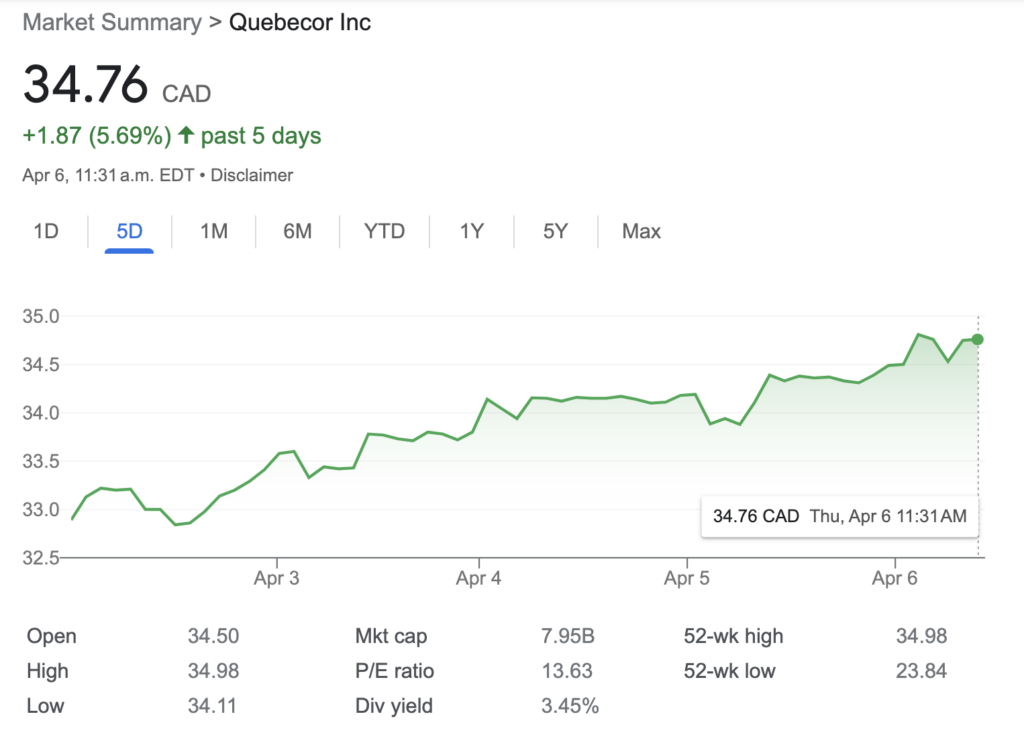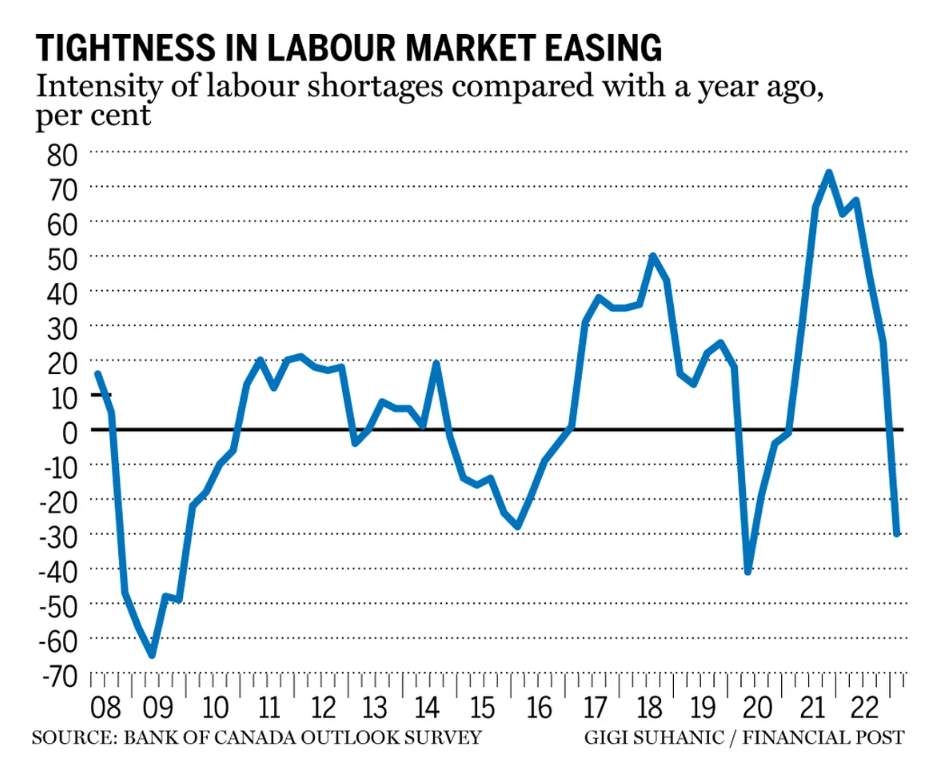Making sense of the markets this week: April 9, 2023
Shaw and Rogers finally tie the knot, OPEC+ sends oil prices skyrocketing, and the Canadian and American economies appear to be slowing down.
Advertisement
Shaw and Rogers finally tie the knot, OPEC+ sends oil prices skyrocketing, and the Canadian and American economies appear to be slowing down.

Kyle Prevost, editor of Million Dollar Journey and founder of the Canadian Financial Summit, shares financial headlines and offers context for Canadian investors.
The long-awaited federal approval of the $20-billion takeover of Shaw Communications (SJR/TSX) by Rogers Communications (RCI.B/TSX) was finally confirmed late last week. There were many stipulations and qualifiers to the deal, but here are the major takeaways for both consumers and investors:
Minister of Industry Francois-Philippe Champagne announces merger of Rogers-Shaw pic.twitter.com/G8fUuuSY6x
— Judy Trinh (@judyatrinh) March 31, 2023
Minister Champagne claims he’ll watch the two “like a hawk.” To us, the basic truth of any merger or buyout is that the companies wouldn’t be doing it if their boards and shareholders didn’t see a major opportunity for profits. Interestingly, though, Canadians’ cell bills are down about 35% since 2017, according to Statistics Canada.
The government and proponents of the deal claim that with Vidéotron now doubling in size, a fourth national mobile carrier should actually increase competition in the market. We’re not holding our collective breath.

Consumer advocacy group OpenMedia described the buyout as: “The largest blow to telecommunications competition and affordability we’ve ever seen.”
Interestingly, Rogers shares are down slightly since the approval, while shares of competitors Telus (T/TSX) and Bell (BCE/TSX) are up. The biggest winner so far appears to be Quebecor (QBR/TSX), with its shares up nearly 7% over the last month.

I don’t think shares of these companies would be rising if the markets believed there was going to be more competition and decreased profit margins. You can read more of my thoughts on Canadian telecommunications stocks at MillionDollarJourney.com.
On Sunday, the countries under the OPEC+ umbrella announced a voluntary cut of 1.16 million barrels of crude oil output per day until the end of 2023.
The news comes on top of a 2-million-barrels-per-day cut that was announced earlier this year.
Prices for West Texas Intermediate (WTI) oil surged to over USD$81 by Wednesday, with several market experts calling for oil prices to end the year at $100.
For Canadians, reaction to the news is likely mixed. If you’re a shareholder in Canadian energy companies, you just received a free bonus profit margin. Look for more special dividends and aggressive dividend raises if the $100-per-barrel predictions come true. If you were a consumer enjoying the deflation of gasoline prices, your summer driving just got significantly more expensive. The Canadian dollar has strengthened versus the U.S. dollar as a result of the pierce increase as well.
Perhaps the most wide-reaching consequence of this production cut will be the effect on inflation. While economists predominantly like to talk about core inflation numbers (which strip out volatile segments like food and energy), real people are about to feel a sting when they fill up at the pumps. And they’ll notice an overall reduction in spending power. Central banks are going to be further backed into a corner, where they’ll either have to stomach increased inflation expectations or risk further systemic failure such as the recent bank collapses by raising interest rates.
With a big interest rate decision coming next week from the Bank of Canada (BoC), the results of this week’s business and consumer expectation surveys were eagerly anticipated. (The BoC overnight rate was held last time at 4.5% after eight increases from 0.5% in March 2022, and many are hoping there isn’t another hike.)
Canada’s business community widely expects sales growth to slow down over the coming year, as inflation remains elevated until 2025. Roughly half of survey respondents said they expect a “mild recession” this year.
Meanwhile, Canadian consumers believe inflation will still be up around 4.3% two years from now. Due to reduced purchasing power, one third of consumers said they were likely to cut down on spending on travel, restaurants and entertainment over the next 12 months.
This pessimism comes despite 0.5% GDP growth in January, and a further 0.3% increase in February.
We’re not sure we agree with the doomsayers.
With labour markets easing and predicted recessions supposedly “just around the corner” for well over a year now, we’re not sure the coming economic apocalypse is going to arrive any time soon.

Down in the U.S.A., the most recent economic data measurements point toward a downturn.
According to the U.S. Labor Department’s Job Openings and Labor Market Turnover Survey (JOLTS) report, job openings fell below 10 million for the first time in nearly two years, and a drop of 630,000 from January.
The JOLTS report supplied the U.S. Federal Reserve with key information in regard to long-term trends in the American labour market. And there is speculation that this loosening of that market may give the U.S. Fed the cover it needs to pause on rate hikes for the time being.
The biggest loser is the professional services sector, while construction jobs led with 129,000 newly created jobs. It was the only sector to see a noticeable increase. Overall, the U.S. unemployment rate held steadily at 3.6%.
In other U.S. economic news, factory order data also came in weaker than expected, down 0.7% from December to February.
Finally, this week, the U.S. trade deficit has grown, as the strong U.S. dollar continues to weigh on foreign sales for U.S. companies. The trade deficit is now USD$70.5 billion per month, as exports fell 2.7%.
While neither Canada, nor the USA, will be amongst the hardest hit countries by increases in oil prices, the overall slowdown of the world’s economy isn’t great news. The main questions going forward for investors are:
Inflation continues to be central to both economic issues and the path forward.
Kyle Prevost is a financial educator, author and speaker. When he’s not on a basketball court or in a boxing ring trying to recapture his youth, you can find him helping Canadians with their finances over at MillionDollarJourney.com and the Canadian Financial Summit.
Share this article Share on Facebook Share on Twitter Share on Linkedin Share on Reddit Share on Email